The inclusion of music and the other arts in interdisciplinary courses should require that each art be studied first for what it is in and of itself; then those things that each may indicate about the others will derive from this primary study. Otherwise, inadequate understanding of music, the visual arts, literature, drama, film and dance respectively could yield only misleading conjectures about any possible interrelationships among these arts themselves and about how they may relate with other areas of concern.
An understanding of any art functioning as art can result only from analysis of the specifically artistic content of works in that medium.1 Obviously, the simple, untransformed reporting of attitudes, experiences or observations is not artistic content; it is either the proper province of journalism or the peculiar concern of soap opera, whatever its medium. For example, works like those of, say, Norman Rockwell or Irving Berlin imitate the outward demeanor of art but merely replicate sentimental attitudes lifted straight from life-scenes. Such popular produce stuns thought, results from virtually none of its own, and demands none in return from its audience. At best it merely manipulates well-known matters or repeats already well-codified relationships. Therefore, it also stunts feeling, for it presents an audience only with the already familiar.
Art, on the other hand, derives from insight into absorbed experience, particularly of the medium itself, and is expressed in the relatively original shaping of selected material. And this does make demands, on the artist and on an audience.
Now if the content of art-works comes not from one's intentions2 and even less from the external facts of his actual experience; if artistic content is, rather, the results achieved, the shaping and working out of ideas in symbols that are specific to a medium, then only through a thorough study of how the artistic material itself is ordered and related, of how it functions in its medium, can we appreciate with any depth the art itself and its works. And this, of course, is the province of analysis, for analysis trains the perception—the sensing and thinking about—the direct experience of art in the terms set out by the art-works themselves.
However; in all the arts except music (as also in the texts for some music), objects and situations recognizable from "life" are frequently the basic material, and what a "picture," "story" or poem refers to in the "real world" may become the mistaken focus of studious attention, at best digressing from art into social commentary.3 But if understanding art really means understanding merely the subject matter rather than its treatment, then not only are no means established for distinguishing "schlock" from art, but "schlock" becomes equated with art, so that all representations of a similar subject, like The Madonna and Child, become esthetically equal, as do all non-representational paintings; and a work like Faulkner's The Sound and the Fury is demeaned into just another commentary on life with "An American Family." If the concern is not for the inventive use of the medium, for the skillful internal construction that makes a work's content more than its mere subject matter, if the concern is only for the referential meaning of a painting or the outline of a plot, then no painting, sculpture or photograph, no prose, poetry, play, film or dance is art; all are equally soap opera.
Like musical analysis, therefore, analysis of any art must focus on the internal, the specifically contextual relationships of a work. Of course, some music is "listened" to not for its music but for its text; and a laurel for profundity may be granted to a work's title, program or ritual associations, regardless of its musical content. And with some music, certain rudimentary, predictable associations may result from the easy perception of elements like tempo and loudness, of certain timbres like drums with trumpets, and of persistent motivic repetition or a relentless metric pummelling. Such conditioned associations are, however, limitations, for they substitute reflex for response and pertain only to the simple and direct but never the complex and connotative aspects of music.
Therefore, reliance on programs gives no clue to hearing the uniqueness of, say, each late Beethoven quartet, and it makes all music without the relationships common to tonality similar and somehow alien. For clearly, except for extremely simple children's music, any substantial responses to the musical material of any work are to be learned, since they are elicited only when an auditor has been sufficiently cued. For obvious examples, the effects of resolutions of German sixth chords are noted appropriately only by those who sense what is statistically more common after dominant seventh chords; the choice of and response to an appropriate raga can be made only by those who are at least somewhat informed about and open to Indian music.
The fact is, then, that in all the arts, concentration on subject matter develops no criteria for perceiving the specifically artistic content of works—the methods of organization. This applies especially to those methods newly developed in the twentieth century. At best, a dependence on extra-artistic references may beguile, but it is a digression from the core of art: the processes of the work itself in its own context, system and medium. That is why musical analysis deals with music in music's own terms, examining the generalized procedures of specified systems and how these procedures are adapted for and applied in the works being studied.
Further, since art affects anyone if and as there is a personal perception of the inner processes of art-works, contextual analysis is an educational necessity, for it focuses on what students may reasonably be expected to attend to, within their levels of competence and within the art-works themselves. And then discussions concerning any of the arts can be based, not on flatulence, but on the students' own perceptions.
The most efficient approach, then, to developing an effective appreciation of the various arts and of both their unique and common concerns is first to analyze individual works in each medium for—or even with—the students. Then connections among the disciplines, historical allusions, social commentary or information about style could relate to the learners' own abilities to perceive the art that all such discussions must ultimately refer to. Now, this analytic approach suits music particularly well for three basic reasons.
First, because music can be discussed significantly only in its own terms, some kind of analysis is probably used in virtually all music courses. If, then, it seems reasonable for the analytic studies of the content of art-works to be the basic reference point of all discussions of art in interdisciplinary courses, it would also seem reasonable for music professors who are relatively aware of analysis and its educational uses to set the approach.
Second, music, being essentially non-referential, is best suited to contextual analysis, for of all the arts, musical analysis most habitually deals directly with the specifically artistic content of its works.
And third, starting from the work of Heinrich Schenker, music has now developed a most efficient analytic method that can explain many if not all of the demonstrable reasons for the quality and effectiveness of works. Particularly in tonal music, each work can be shown as an organic totality of interacting levels and nested layers, as a dynamic entity that evidences its own uniqueness while simultaneously defining the operations of its harmonic system as it proceeds. Further, some of the procedures—or at least attitudes and discipline—can be extended to non-tonal music. And the principles and concepts are applicable to the other arts. They may even be transferable to other fields of study as well.
The examples referring to Beethoven's First Piano Sonata, opus 2 #1, in F Minor, may illustrate typical analytic processes, somewhat simplified to make them accessible to students with limited technical vocabularies. The basic approach is simple, although the implementation may be complex: to discover the units of organization within the piece itself and the relationships among these units.
The sketch (Ex. 1) should be self-explanatory to musicians in terms of harmony and form.
*EX. 1—Beethoven—Sonata, op. 2 #1
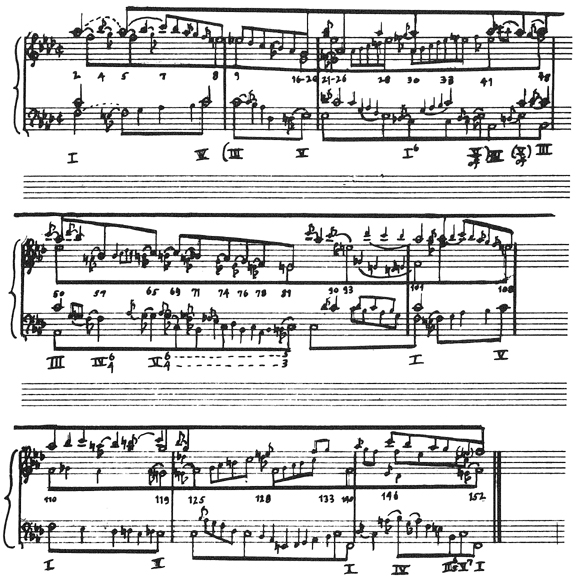
*See also, Schenker, Heinrich. "Der Tonwille." vol. II, 1922, p. 25. Tonwille-Flugblaetterverlag, Leipzig.
For students, particularly general students, the harmonic motion and definition would be presentable in terms of the stability of certain segments (the opening thematic statement, the "codetta" and the "recapitulation and coda") and the instability of others (the motion toward III after m. 8 and the "development section").
In terms of the techniques for constructing the melody that correlates with the harmonic foundation, explanation would pertain to the following:
a. mm. 1-8: "theme A" contains a two-measure unit, with what will later become two motives, a triad encompassing a minor sixth and an embellishing figure; then, after the two-measure unit is sequentially repeated, it is compressed to half its length (the grace note being a variant of the arpeggio, so that the entire unit, not just the embellishing figure, is still present), with a return to the original length for the cadence, now adding a scalar descent that fills in the minor sixth C-
.
b. mm. 9-20: using the embellishing figure only as a local motive, this scalar descent is replicated over a longer time span, here descending the minor sixth from the fifth to the seventh scale-step of the prospective temporary tonic (
-G of
) just as the referent C-E descent moved from the fifth to the leading-tone of the original tonic, F. This is a reflection of the "small" events of the piece into one of the "larger," more background layers. Then, this
-G descent is compressed from a seven-plus measure unit into two measures, and the G resolves to the
of m. 22, with the
chord here retaining the instability.
c. mm. 21-48: the
-
chromatic change that began the harmonic motion toward III in mm. 8-9 becomes the
-
local motive of "theme B" in mm. 21-25, which also contains an embellishing figure like the one in "theme A." Mm. 26-41 develop this figure motivically, ascending to
, with the
-F-
contour of mm. 30-36 being a clear elaborated inversion of the referent
-G-
-of mm. 18-22.
d. mm. 49-100: in order, the motives of the two themes elaborate and stress the
of m. 50, the
of mm. 57-59 and the C of mm. 65-67. Then the bass becomes motivic, and this change in roles signals a new area, where a scalar descent, again from C to E, is elaborated. Clearly, therefore, mm. 49-81 of the "development section" is a large elaboration of the small opening statement, mm. 1-8, with direction derived from the structure of this expanded statement.
e. mm. 101-152: the "recapitulating" of mm. 1-48 is followed by a final arrival at the tonic after one more repetition of the C-E descent (in the "coda"), finally resolving the leading-tone to the tonic, F.
Critics of the Schenkerian approach to analysis occasionally lament the omission of the "notes in between" the structural notes from the reductions and the fact that rhythm is not considered in the analyses. This is certainly no longer true, if, in fact, it ever was. The background sketches show large scale motion; the sketches of the foreground contain the "notes in between," showing their functions. And rhythm is part of all analyses, as are the other parameters, wherever applicable. Rhythm is used in this analysis at least to identify motivic shapes and is central to the entire matter of compression and expansion of such units. Further, the question of accent is vital when this analysis is applied to performance, e.g., should a stress occur on the first or third beat of m. 2 and all similar measures but on the first beat of m. 5, as indicated, perhaps, by the rising line of the opening statement and by the placement of all the structural notes of the "development section" on the sf third beats of their respective measures.
Nevertheless, this analysis is not intended to be complete. For example, the principal notes of mm. 7-8 are C-( -)G-E, since the
-)G-E, since the  and F are both dissonant; this shape might, therefore, be considered a filled-in inversion of the opening C-F-
and F are both dissonant; this shape might, therefore, be considered a filled-in inversion of the opening C-F- , so that all derivatives from the C-E scalar descent are, ultimately, developed variants of that original opening motive. This analysis is a study aid, meant to be compared with the piece itself to provoke further conjecture. For example, the cadence on V in m. 8 looks stable in the sketch; but the score shows the bass omitting the downbeat in favor of the off-beat. In a large rhythmic sense, this would make the "stable" opening a long upbeat to the ensuing instability. Then, in the corresponding place in the "recapitulation," mm. 105-108, where the bass stresses the downbeats, a greater sense of stability results.
, so that all derivatives from the C-E scalar descent are, ultimately, developed variants of that original opening motive. This analysis is a study aid, meant to be compared with the piece itself to provoke further conjecture. For example, the cadence on V in m. 8 looks stable in the sketch; but the score shows the bass omitting the downbeat in favor of the off-beat. In a large rhythmic sense, this would make the "stable" opening a long upbeat to the ensuing instability. Then, in the corresponding place in the "recapitulation," mm. 105-108, where the bass stresses the downbeats, a greater sense of stability results.
The more detailed discussions that might relate, for example, the E-C ascent of the bass line in mm. 3-8 to its inversion in mm. 7-8, might not be pertinent in interdisciplinary courses. The structural delineation of form, however, would be; for, although the movement is describable in the terms typically used for "sonata form," structural analysis shows the "development section" as not merely a succession of harmonic wanderings but as one overall directed motion resulting from its totality being an expanded elaboration of "theme A." And it shows the rest of the movement, not as blocks of time, but as motion within varied time spans from one defined point to the next and as the events of the foreground unique because of the compositional techniques used.
The analysis, then, focuses only on the work's motivic and structural content, its medium and its system, tonality, relating detail to detail and showing these details as nested within the longer-lined, direction-controlling background layers. Derivable from the analysis of the work's specifically musical content are comments about its style and quality, since traits such as economy of organization, the function of motive and theme in overall structure, and the coherence of the total discourse are observable and implicit in the analysis.
With more problematic works, like the first of Schoenberg's Six Little Piano Pieces, op. 19, analysis might have to be more indicative than illustrative; but the intent here is to demonstrate the applicability of a method, not to get right answers. Of course, a Schenkerian approach, appropriate to tonal music, might mislead when extended to non-tonal pieces like this one; but observation of the piece showed that a Schenkerian sketch would be useful, not to impose any preconceived functions of tonality, but as a tool. Therefore, a reduction was attempted only after it was noted that contiguous segments were linked by common tones and generally stepwise motion and that the treble's opening notes, B- , were obviously repeated as the first and last notes of the total structural line on the upper registral level. However, unlike tonal music, where individual works project more or less uniquely a generalized harmonic system, this piece has both a unique foreground and a structure that adapts inherited structures to its own new vocabulary.
, were obviously repeated as the first and last notes of the total structural line on the upper registral level. However, unlike tonal music, where individual works project more or less uniquely a generalized harmonic system, this piece has both a unique foreground and a structure that adapts inherited structures to its own new vocabulary.
Schoenberg's compositional techniques are similarly at least reminiscent of prior practices, and further commentary might refer, for example, to some of the following (see Ex. 2):
EX. 2—Schoenberg—Piano Piece, opus 19 #1
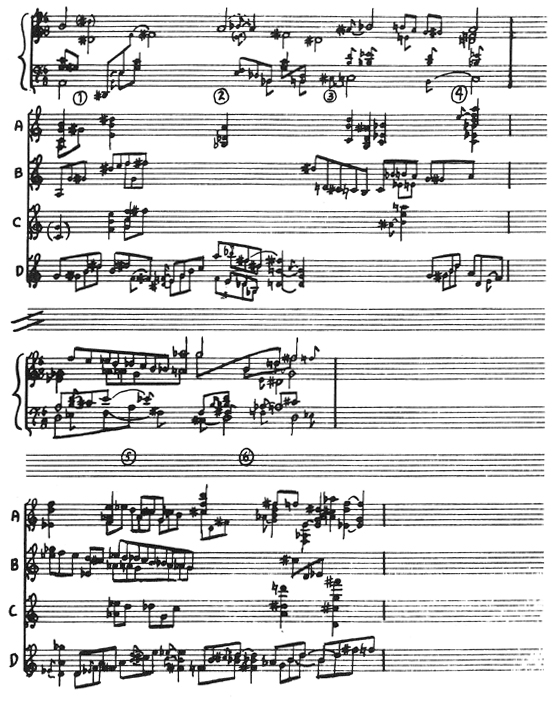
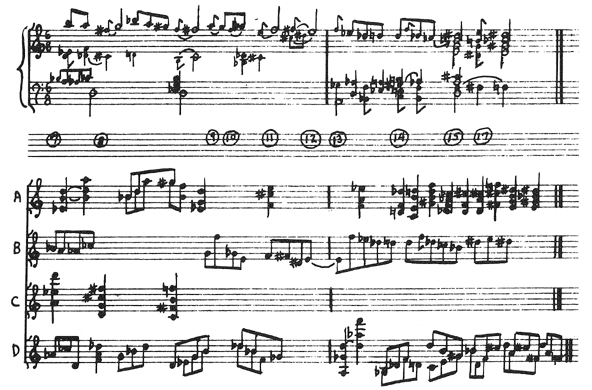
1. the indications and motivic basis of Schoenberg's serialism and his concern for specific pitch-classes (e.g., the recombining of notes from the same pitch-classes into related groupings: the opening dyad B-
, first-part of the opening line B-
-F-
, recurs in the chord
-B-E as an accompaniment to the F in m. 1).
2. the modification of tonality's constructs (e.g., the triad-plus-adjacent-note composition of motivic variants: B-
-(F-)
, A-(
-)F-
, F-(E-)
-
in mm. 1-2).
3. the relating of the "horizontal" and the "vertical" (e.g., the "triadic" motive of A-(
-)
-
in the melody line of m. 2 equals its accompaniment of F-(E-)
-
).
4. the Schoenbergian concept of "developing variation,"4 a clear continuation of earlier composers' practice (e.g., the triad-plus-adjacent-note motive recurs in all guises; or the chromatic motion of the opening, G-
and F-
, that is first included in a larger, more various line gradually develops to the totally chromatic line in the treble of mm. 4-5).
This is, of course, only the start of an analysis of this piece. One problem is the organization of simultaneities, for four types of constructs engender both the simultaneities and the lines, and that seems too much for such a short piece. Clearly, then, more work is required. But even this analysis should indicate how much is inferable from a study of musical context, the units of a work's organization and the relationships among them.
Moreover, such an analysis suggests that the primary articulators of musical organization are pitch and rhythm in most music, except in totally-organized works, where all parameters co-function, or in works using newer methods of organization of, for example, timbre. And obviously, only after consideration of the interactions of all the elements can any estimate of primacy be made. But in most music, pitch and rhythm are the compositional substantives; and if in some such works, secondary aspects alone simulate activity but have no substantive organization or structural motion to sustain it, the result is an unimpelled busy-ness, a redundant, essentially artificial stimulation and imitation excitement.
Now analytic techniques similar to those used and esthetic considerations similar to those derived in music can be applied and demonstrated in the other arts, although in interdisciplinary courses, medium-specific information and insights would probably be supplied by each professor in his own field. For example, the visual arts sometimes make use of psychological, religious or mythic symbols; and such symbols, with their complex connotations evocable by one image, may be a legitimate concern of searchers in other fields, e.g., C.G. Jung or Claude Lévi-Strauss, who interpret them for what they mean outside of art. The concern here, however, is for artistic significance, for the symbol as artistic material, since it now functions, like every other aspect of the work, as part of a context. Where extra-artistic symbols are important in a work, the artist has—consciously or not—chosen them and realized them with painting's own means: shapes, colors, lines, textures, etc., and then these relationships have been incorporated into an organized context. Even if the borrowed symbols were to remain fundamentally unfathomable, the composition of the context can be analyzed, and obviously the more clearly a viewer perceives the shapes functioning in their context, the more meaningful will both the symbols and the art-work be.
The analyses here, therefore, will be concerned only with the composition, the construction of the art-works: their "motives and motivic development," the relation between the motives and the overall structure and whatever compositional techniques may be observed. For example, in Jan van Eyck's "Arnolfini Wedding" (Ex. 3), the technique of varied repetition is applied to the motivic shape of the chandelier: it recurs, larger and progressively less curved, first in the line that goes from the man's hat, down his left arm and to the woman's arm, bosom and headgear; second, in the contour created by the man's total figure, the dog and the woman's total figure; and third, in the largest construct, the background shape defined by the window and table, connecting to the red furniture, floor and rug in the center and then to the bed, this last shape being completely angular.
EX. 3. Jan van Eyck: "Arnolfini Wedding" (Reproduced by courtesy of the Trustees, The National Gallery, London)
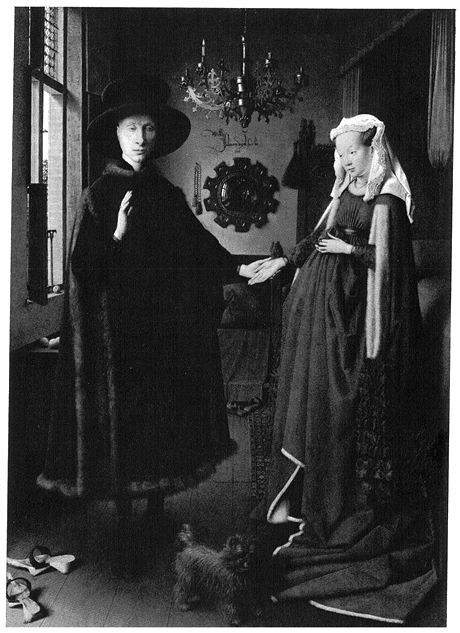
The gradual change in these shapes from curved to more and more angled as they become larger assures their being recognized as similar and therefore varied forms of the same motive as well as connecting this motive to the large structure. At the same time, a second variant changes this motivic shape in the other direction, to the completely curved circle of the mirror right in the painting's center, this curve being allusive, perhaps, to the woman's pregnancy.
Irrelevant response could result from extra-artistic information about this work, from a literal translation of its obvious subject matter into words that should, somehow, enhance our sensitivity to it as art. Art, however, is more than the trivial game of allegory, the flat, one-for-one substitution of a "picture" or "story" for a statement or emotional state. Therefore, it is not really important why certain objects are included in a painting or what its "purpose" was; the analytic approach focuses on why the particular organization of the objects, whatever they may refer to, is affective; it focuses on movement and composition as the expressive content of an art-work, just as in music. Consequently, the placement of the dog, and not merely its inclusion because it "represents faithfulness," is the artistic concern. Similarly, the external purpose of the painting's having legalized a marriage is a curiosity, and regarding such trivia as an "intellectual concern" causes intellect to be set against emotion. However, when composition is the core concern, genuine intellect and feeling become integrated into one response. The analysis, therefore, even so brief a one, deals with the artistic content, the constructive use of motivic shapes, large structure and their interdependence in order to achieve this integration.
Even more than with the music discussed earlier, this is only a start. The intent here is only to indicate an approach that would recognize a work of art as a changing of its subject matter into the artist's material which is then shaped into its own newly made reality. The woman's pregnancy, for example, regardless of who was responsible for it, became motivically integrated into this painting. The artistic reality, and not the external references, should be and can be the core of discussions of art.
Largely, an analysis begins with a simple description of the work's material and organization; but when the discussion leads to how the material activates and articulates space, it becomes more than just description, like the musical analysis that goes beyond identifying chords and motives to a study of the musical motion that activates and articulates time spans. Also, the analysis is in compositional terms that may apply with equal efficiency to either representational or abstract styles and that may as with the musical analyses discussed earlier, become the objective basis of categorizing or evaluative determinations.
An even more explicit example of why composition and not subject matter alone is art is Amedeo Modigliani's "Nude" (1917). The quality of flesh tones, particularly as projected against the white sheet and deep blue and red background, seems quite clearly sensual; but note the use of geometric shapes: the triangle, both motivically and structurally, and contrasted to them, the rounded shapes of the body's components that become, therefore, compositional elements, motivic material structurally integrated into the painting (Ex. 4).
EX. 4. Modigliani: "Nude" (The Solomon R. Guggenheim Museum, New York)
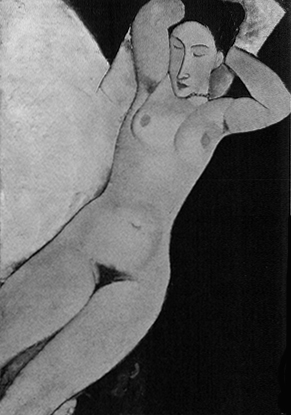
Compare this now with any photograph of a nude female human printed in one of the popular "girlie" magazines. The subject matter, the referential, extra-artistic associations to the body and not the composition of the total context is the focus of attention. To be sure, both pieces may provoke either a "prurient interest" or an annoyance at the sexist exploitation of women, but the response to the Modigliani painting should be of a different order.
Response to visual art's subject matter alone is, like response to only the dynamics, tempo or activity of almost all music, a relatively easily achieved reaction to secondary—most frequently superficial—aspects of art-works. The primary, substantive matter of the visual arts, like harmonic and melodic relationships in music, is more likely to be the use of motivic shape, line and color to create structural movement in and articulation of space, and the compositional techniques of the artist. Perhaps there is no "Ursatz" or nesting of various constructs, but certainly the compositional layers do interact.
An advantage accrues to music professors in these discussions. For while analytic procedures may be efficiently demonstrated with music because its general non-reference to any "real world," the application of these procedures can be observed more clearly in the other arts, for here observation does not require, as music certainly does, the use of relatively unfamiliar technical terms and written representation. Therefore, in the other arts, conclusions as to what "schlock art" is or how artistic organization is affecting can be shown more objectively and comprehensively. And density (referring to the ratio of substantive relationships per event in a work) can be a useful criterion in all the arts and can also be more easily demonstrated in paintings than with music.
Focusing on the specifically painterly organization of motives and the structuring of movement, areas and space allows for the following: comparisons of paintings that have similar subjects or similar construction; an approach to contemporary or non-western works; and relating music to the visual arts' real content as art—its composition.
Even more than with the visual arts, however, many discussions of prose, poetry, plays, dance or film seem to refer to the "real world" supposedly depicted rather than to art. For example, Dickens' themes are connected to the social conditions they use and to their social messages; Antonioni's plots are extracted for their symbolic or psychiatric meanings. Occasionally, however, especially with film, discussion swings the other way and virtuosity in the medium's technical capabilities seems more important as an end in itself than as a means toward creative, continually inventive composition.
Now concern with themes, meanings, sources, tools and dexterity is necessary but not sufficient, for the problem remains that the road to "schlock" may also be paved with great intentions, sincerity, and virtuosity. Further, certain works remain valid even when their socio-political statements are dated, their plots familiar, or their virtuosity no longer amazing; for they make cogent artistic statements as well.
Of course, many novels, plays and films are supposed to be popular entertainment, with preconditioned responses built in. But an analogy can be seen between the interest in, say, a symphony's tunes rather than in its structural motion and the overriding interest in a drama's story rather than in its composition, since such interest is a sign that most of the work is being missed. Just as the photograph of a young nude woman can be "liked" for reasons other than esthetic, so folk songs, popular music of any decade, the music of various Strausses, most movies, the most common fiction or drama may have appeal for reasons such as political, ethnic or age-group identification and the need for belonging, or for reasons such as nostalgia, the friendliness of the familiar, or the confusion of a fleeting topicality with genuine relevance.
In fact, the products of popular culture can be well used to demonstrate that education in entertainment is hardly needed; consider courses such as "Toward a Deeper Appreciation of 'The Brady Bunch' " or "Truth, Technique and Symbolism in the Films of Clint Eastwood." This holds for all media, for an interest in only those works that are readily and almost wholly accessible at first sight or hearing denies the possibility of continuing deepening experiences. And to change that attitude and work toward a literate, perceptive audience, education is certainly necessary.
Therefore, structural analysis of art in all media is a proper approach to teaching interdisciplinary courses involving any of the arts. If not the basic approach, it should, since it deals directly with the core material of the course, at the very least be complementary to whatever other approaches are used.
Since a discussion of an entire play, film, novel, dance or even short story would hardly be feasible here, perhaps an analysis of some poems would serve to indicate how written texts may be approached and their internal organization perceived. A large body of poetry is, of course, narrative, dramatic or descriptive, so that comments on rhythm and meter, simple phonemic relationships and diction would ordinarily suffice as to what setting the subject as a poem adds to the subject.
For example, an analysis of Alfred, Lord Tennyson's "Break, Break, Break" shows a syntactic structure that distinguishes between the words giving each sentence its essential meaning and those expanding and modifying this meaning (Ex. 5).
EX. 5. Alfred, Lord Tennyson. "Break, Break, Break" (1842)
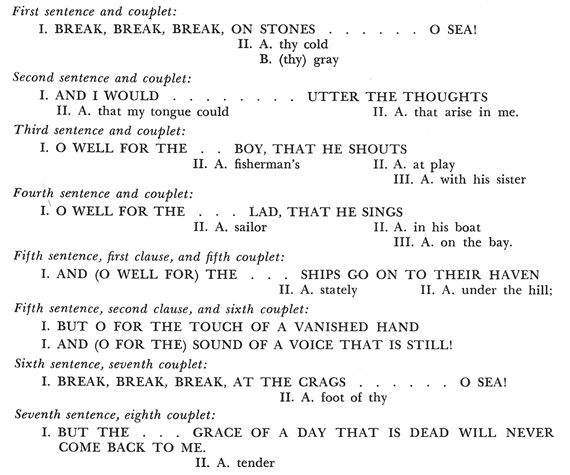
This shows that there is a good deal of mere filler. For example, in line 3, "that my tongue could utter" adds little to "I would utter" or, for internal rhyme, "I would that I could utter"; it serves only to announce to the reader, "Look, I'm a poem," because it is the traditional diction of poetry. But such commonplaces function in no other way, adding no effectiveness here.
The construction of the poem itself has eight statements, each in its own couplet, recounting the poet's reaction to this friend's death. Certain simple symbolism is apparent in the "ships (going) to their haven," evoking the image of the friend's soul going happily to heaven while the poet is, sadly, still alive. And some technique of composition gives couplet one a double image, with each part used separately: couplet two contrasting with the first, and couplet eight with the varied repetition, couplet seven.
But no images are developed. For example, the continual references to water form a string rather than an intensification; and the opening contrast of water and rock is simply abandoned, replaced by "the foot of thy crags," a less effective construct than line two's "thy cold gray stones." The question is, what may have impelled the change to the less effective variant?
As to rhythm, only lines one and thirteen offer more than a minimal deviation from the standard metric scheme; and there is little phonemic development.
Unless this analysis is very incomplete or inept—and that is certainly possible—it shows that some poems, like some music, neither require nor benefit from analysis. But other poems, particularly recent ones, yield greater meaning after analysis. Furthermore, analysis of poetry produces feedback to music; first, because questions similar to those asked about music's motivic and harmonic development are asked about poetry: are the additions to the basic structure substantive or mere filler; is the use of traditional forms and formulations functional and pertinent or mere inertia; is there continual invention after as well as in the opening statement; are the medium's possibilities used with originality, wit and creativity?
And second, one basic element of the method is syntactic analysis, which by its very nature distinguishes structure from elaboration and embellishment. For example, with Dylan Thomas' "A Refusal to Mourn the Death, By Fire, of a Child in London," an attempt to discover what poetry adds to the literal statement leads to the construction of a basic layer (the background) and the modifying and enriching layers (the middle- and foregrounds) that are represented as nested within it (Ex. 6).
EX. 6. Dylan Thomas. "A Refusal to Mourn the Death, By Fire of a Child in London" (1946; 1952)
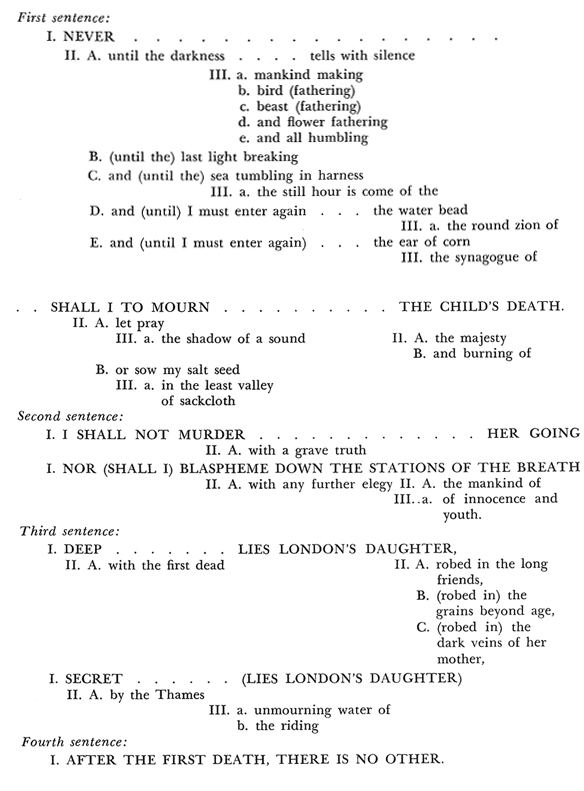
A study of this sketch indicates the following:
1. The rhythm of the whole poem is cumulative, as reflected in the first sentence, where the foreground is longest at the start because of the series referring to "darkness," is shorter through the next segment, is of intermediate length near the end, but disappears at the end of the sentence, its last line (13) being all middleground and background to emphasize its impact; as reflected also in the similar, although shorter, structure of the second sentence. But the tempo slows down in the third sentence because of its symmetrical construction, with a long middleground in the center and shorter ones at each end. The last sentence is the shortest and slowest, like the end of the first, for it too is virtually irreducible—it is all background, all substance and structure.
2. The structural layers of each sentence that correspond in syntactic function also correspond in poetic function, i.e., the background layers make direct statements without imagery, the allusions to religion occur in the other layers.
The analysis could have started from the first detail, since poetry, like music, is perceived in time. Then, we note that "never" and "until," the first two words, are contradictory in meaning, for if there is an "until" there cannot be a "never." This opposition is reflected in the accenting of the two words: név-er and un-tíl. Except for the single word "again," every word between "until" and the next structural point, "shall I," strengthens the "never," literally because the reversal of natural events described here can become possible only, as is indicated in the poem, on Judgment Day, and rhythmically because all the words repeat the accenting of "never," reinforcing it and not its opposite through motive-like development. To test this, substitute "not until" or "only when" for "never until" and compare the effectiveness. And a further development of the "never-until" contrast motive is the juxtaposition of contrasting words that results in the impossible natural events, e.g., "tells with silence," "sea in harness," "sound" with a "shadow." These contrasts develop, as a musical work would vary, the opening motive.
As to sound, students of literature would certainly note the alliterations (e.g., "mankind making," "bird beast"), the rhyme scheme (ABCABC) and even the relation of certain phonemes to specific effects (e.g., the nasal n's, m's and ng's of the opening with the occasional staccatos on t and k becomes the voiced b of line two and finally the outflowing f's and open vowels of "flower" and "fathering," this developing into a whelm of s, sh and z sounds from "darkness" and "silence" through "sackcloth," finally returning to the matched and therefore reciprocally reinforcing m's and n's of "mourn," "majesty" and "burning." Similarly, the d's and t's of line nineteen are clearly phonemes supporting morphemes).
After an analysis of syntactic structure, literal meaning, rhythm and accent and phoneme choice, there are still the poem's symbols, images and connotations to discuss. Students with training and convictions in religion will certainly respond to a religious interpretation, supported by clear references to creation (lines 1-3), to Judgment Day (lines 4-6) and the use of words like "zion," "synagogue," "pray," "sackcloth," "blaspheme" and "stations of the breath" (allusive to "stations of the cross"). But it is sufficient here to indicate that symbolic interpretation has a range that might best be explored by individual readers and that structural analysis, restricting itself to the poem's context, can support a reading, show interrelationships, and give direction to further discoveries. For example, this "refusal" may be a greater remembrance than any typical lament, and "death" may not be its topic, for the reversal of the process of parturition referred to in lines 7-9 points to the child's and our becoming one again; or the last sentence may be interpreted as realistic, symbolic or both.
It should be noted how much of musical analysis pertains here: rhythm, motive, sound and meaning, structure and detail, and how the analytic approach and technique avails. The emphasis is not on the answers proposed but on the questions asked that lead, hopefully, to insight. It should also be noted, of course, that just as "expressivity" and uniqueness in music depend, for example, on the dissonances and local motives that appear only in the foreground, so also the poem's fore- and middlegrounds are indispensable for its power. The analytic sketch only relates, as in the Beethoven Sonata discussed earlier, these cogent details to the direction-giving overall structure. In the totality of the poem or musical work, neither layer is more important: each has its function, the functions complementing each other. The sketch shows their interacting.
As with the previous analyses, further study of this work may well indicate areas untouched so far. Scholarly references may also add dimensions that have simply not been mentioned. But the intent here, as before, is to illustrate a method for finding out why the poem is interesting enough to impel investigation into its sources, a method for showing how the content makes it evocative, and how the intrinsic, specifically poetic qualities may be discovered more effectively and demonstrated more convincingly.
As with painting, the poetic analog to music's Schenkerian "Ursatz" may be problematic. But the investigation itself is, after all, the real activity, whatever the results. Particularly is this so in education. In any case, each medium probably has its own structures resulting from its own properties, just as the Schenkerian layers and levels follow from the composers' use of tonality. What does transfer is analytic method and attitude.
We know too that searchers in other fields are using what they also call "structural analysis"; Lévi-Strauss and Noam Chomsky, for example, are attempting to posit a structure of the human mind from studies of myth and language. There may be marvels here as there are in art. And true marvels do not vanish when contemplated carefully; rather, their impact intensifies as we perceive them better. Our function is to improve that perception—our students' and our own. Analyzing music for its structure helps our hearing of it and thereby our appreciation of it. If transferred sensibly, the methods for analyzing music may help our understanding of other fields.
1Martin Maloney, "A Grammar of Assassination," in The Use and Misuse of Language, S.I. Hayakawa, editor (Greenwich, Ct., 1962), pp. 129-130 et passim. See also, Susanne K. Langer, Philosophy in a New Key (New York, 1942), p. 20ff. et passim.
2W.K. Wimsatt, Jr. and Monroe C. Beardsley, "The Intentional Fallacy," Essays in Modern Literary Criticism, Ray B. West, Jr., editor. (New York, 1952), pp. 174-189.
3José Ortega y Gasset, "The Dehumanization of Art," in The Dehumanization of Art (New York, 1956), pp. 9, 11 et passim.
4Arnold Schoenberg, "New Music, Outmoded Music, Style and Idea," Style and Idea (New York, 1950), p. 39. , "Folkloristic Symphonies," ibid., p. 200.


